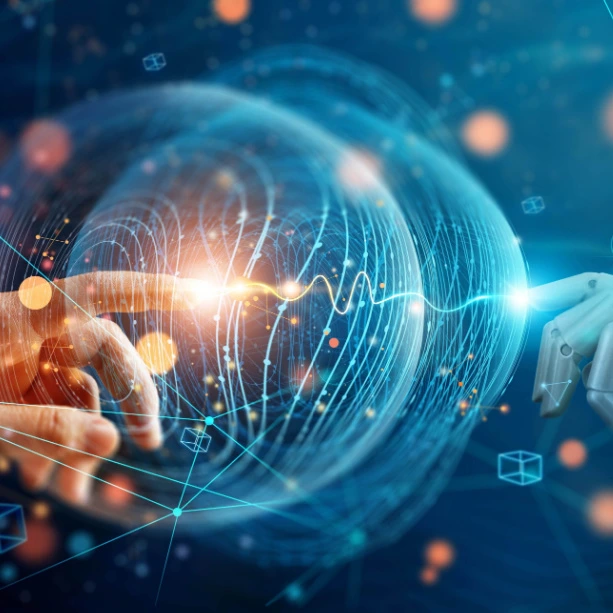Data and artificial intelligence (AI) have revolutionized our world, and they continue to do so. This modern technology's capabilities are astonishing, and we have good reason to believe it has yet to achieve its full potential. Even so, through AI, we are achieving levels of automation that our ancestors could not have imagined, reaping the benefits with a safer, more efficient, and more responsive workplace. However, not all AI operates in the same way or has the same capabilities. There are four main types of AI, and each type serves a specific purpose. Let’s look at the different types of AI and where they stand on the blurry scale between science fiction and science fact.
Reactive Machines
The most basic form of AI is reactive machines. All they can do is react to immediate situations. They can’t store memories or influence decisions; they simply operate on a base code to complete a limited task or set of tasks. There is no planning involved with reactive machines; they simply react to the environment surrounding them. Reactive machines are typically seen in movies and TV shows when robots play board games. They are helpful within manufacturing contexts in that they always respond to input with a corresponding output, creating consistency.
Limited Memory
Limited memory AI can store basic data and make limited predictions based on that data. Asset tracking is a great example. These systems have sensors that monitor environmental conditions, including acceleration, temperature, shock, and more. Limited memory has become the most commonly used AI technology due to its relative simplicity and wide variety of applications. The primary advantage of AI is its ability to sort and classify information in a readable way that renders collected data more accessible for the user.
Join the AirFinder Difference!
- Innovation. Organizations can be freed up to innovate and bring more impactful products and services to market.
- Profitability. Increased profitability provides new opportunities to innovate and improve valuation.
- Digital Transformation. Discover competitive advantages, new revenue opportunities, improved customer relationships, and increased efficiency.
Theory of Mind
People’s thoughts and emotions influence their actions. Theory of mind AI works to understand these thoughts and emotions and how it impacts human actions and reactions. This AI can have real-life conversations with humans and make decisions based on the emotions they observe in the human conversationalist. Some can even simulate emotional expression based on this understanding. This type of emotionally intelligent AI is still being developed and will most likely be used primarily in psychology practices.
Self-Aware
Right now, self-aware AI only exists theoretically and, of course, in the realm of science fiction. When AI is self-aware, it is aware of what it is and the fact of its own existence. These systems will go above and beyond understanding emotions and feelings to develop their own, the same way humans have emotional responses to what happens around them. Self-aware AI is what people typically think of when they think of AI, and the idea of this technology existing often makes people nervous. What are the implications of self-aware, sentient technologies? How will it change the human experience and the role of humanity? Will we inevitably anger our creations into destroying the world, or at least the world as we know it? There’s no way of knowing, but there’s also no reason to worry – self-aware AI is a long way off.
AI Applications in Manufacturing
Both reactive AI and limited memory AI are widely used within manufacturing contexts, often with some degree of overlap in the types of tasks they complete depending on the unique demands and desires of a particular company. This use of AI to augment operations has several benefits within the field.
Improved Efficiency and Output
AI is used to increase daily efficiency, which increases a company’s output as a natural result. These machines allow for the automation of repetitive, tedious tasks that might otherwise monopolize a worker’s time. In doing so, they free up workers to focus their attention and effort on more important tasks, creating a more efficient system overall.
Improved Preventative and Predictive Maintenance
To keep operations running smoothly, much of a manufacturer’s equipment needs to be monitored for breakdown. The best way to avoid this is through continuous predictive maintenance by checking on the equipment’s condition before it breaks down at an inopportune time. AI can automate this task, alerting workers when their equipment is likely to break down, thus minimizing downtime.
Quality Consistency
The mark of a good production process is products are made with comparable quality to one another. Quality products help manufacturers build a reputation for reliable operations. Humans, however, are not always predisposed to having an eye for this kind of detail. It’s especially easy to miss something when you have other work to do and a quota to meet. AI can help lessen this burden by analyzing products for quality consistency, only needing to call in human workers when reduced quality needs to be remedied.
Employee Safety
Manufacturing plants and the equipment found therein can be incredibly dangerous. In the best case scenario, the workers operating or working closely with this equipment are adequately trained and do everything right every single time, and the danger is a moot point. But humans are fallible and can become complacent in tasks they perform on the regular. AI can automate some of these dangerous tasks, keeping workers out of harm's way. Alternatively, in tasks that require human input, AI safety guides can be put in place to automatically respond to operational errors or other potentially dangerous situations.
Inform Operational Decisions
One of AI's most overlooked advantages lies in its ability to compile data. Depending on the type of AI at play, it might even analyze and visualize data for the user. Ignoring this aspect of AI means ignoring one of the most significant benefits of the technology. The data provided by AI can be used to make informed decisions about future operations and to analyze the effectiveness of any operational changes that have been implemented. Operators can back up their purported success with numbers and use those numbers to continue to improve.
How AirFinder Has Incorporated AI
AirFinder is an asset tracking solution that automates companies' WIP processes, supply chains, and more. AirFinder uses limited memory AI technology to monitor the environment surrounding the asset tags, providing readable location and condition data. Environmental monitoring provides the most accurate reporting information, so users can make informed decisions. To learn how our solution works, book a demo with us.




